Kenwood VR-510 User Manual

AUDIO VIDEO SURROUND RECEIVER
VR-510
INSTRUCTION MANUAL
KENWOOD CORPORATION
Preparation
About the supplied remote control
Compared to standard remote controls, the remote control supplied with this receiver has several operation modes. These modes enable the remote control to control other audio/video components. In order to effectively use the remote control it is important to read the operating instructions and obtain a proper understanding of the remote control and how to switch its operation modes (etc.).
Using the remote control without completely understanding its design and how to switch the operation modes may result in incorrect operations.
Operations
B60-4957-00 00 MA (K, P) |
0011 |
Remote Control
Additional Information
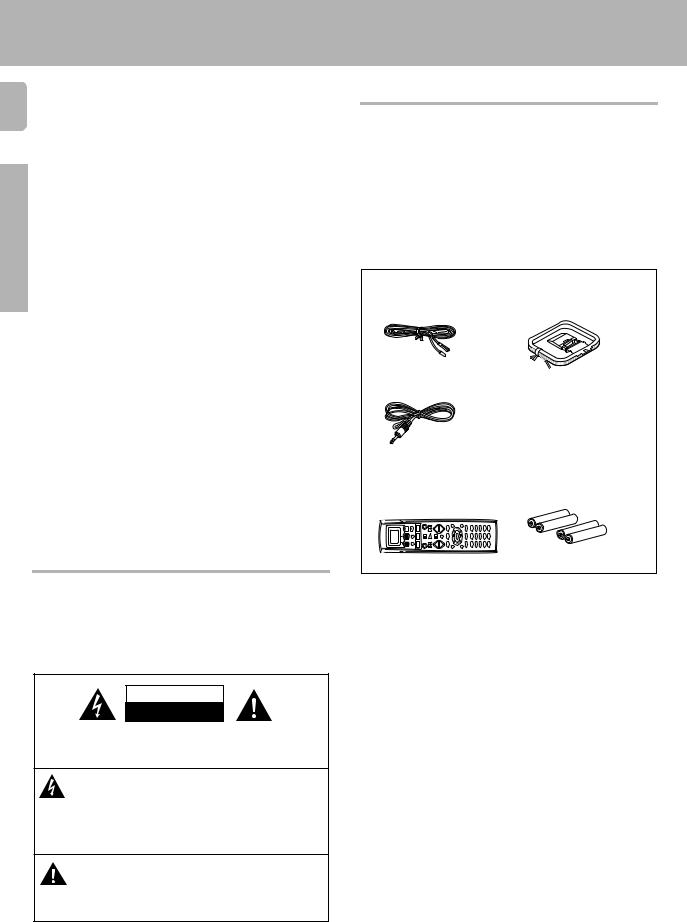
Before applying the power
This unit is designed for operation as follows.
2
U.S.A. and Canada |
........................................... AC 120 V only |
Australia ........................................................... |
AC 240 V only |
Europe and U.K. ............................................... |
AC 230 V only |
China and Russia ............................................ |
AC 220 V only |
*Other countries ......... |
AC 110 - 120/220 - 240 V switchable |
Preparations
Safety precautions
WARNING :
TO PREVENT FIRE OR ELECTRIC SHOCK, DO NOT EXPOSE THIS APPLIANCE TO RAIN OR MOISTURE.
CAUTION
RISK OF ELECTRIC SHOCK
DO NOT OPEN
CAUTION: TO REDUCE THE RISK OF ELECTRIC SHOCK, DO NOT REMOVE COVER (OR BACK). NO USER-SERVICEABLE PARTS INSIDE, REFER SERVICING TO QUALIFIED SERVICE PERSONNEL.
THE LIGHTNING FLASH WITH ARROWHEAD SYMBOL, WITHIN AN EQUILATERAL TRIANGLE, IS INTENDED TO ALERT THE USER TO THE PRESENCE OF UNINSULATED “DANGEROUS VOLTAGE” WITHIN THE PRODUCT’S ENCLOSURE THAT MAY BE OF SUFFICIENT MAGNITUDE TO CONSTITUTE A RISK OF ELECTRIC SHOCK TO PERSONS.
THE EXCLAMATION POINT WITHIN AN EQUILATERAL TRIANGLE IS INTENDED TO ALERT THE USER TO THE PRESENCE OF IMPORTANT OPERATING AND MAINTENANCE (SERVICING) INSTRUCTIONS IN THE LITERATURE ACCOMPANYING THE APPLIANCE.
 Caution : Read this page carefully to ensure safe operation.
Caution : Read this page carefully to ensure safe operation.
Unpacking
Unpack the unit carefully and make sure that all accessories are put aside so they will not be lost.
Examine the unit for any possibility of shipping damage. If your unit is damaged or fails to operate, notify your dealer immediately. If your unit was shipped to you directly, notify the shipping company without delay. Only the consignee (the person or company receiving the unit) can file a claim against the carrier for shipping damage.
We recommend that you retain the original carton and packing materials for future use should you transport or ship the unit in the future.
Keep this manual handy for future reference.
Accessories
FM indoor antenna (1) |
AM loop antenna (1) |
RF remote antenna (1)
Remote control unit (1) |
Batteries (R6/AA) (4) |
RC-R0812 |
|
+ – |
|
+ – |
|
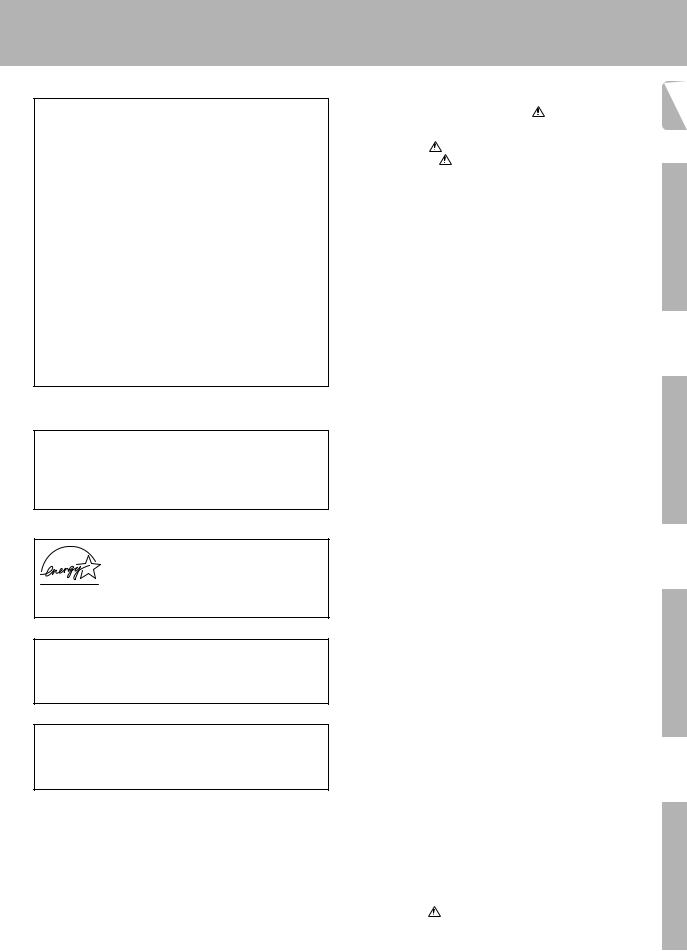
For the U.S.A.
FCC WARNING
This equipment may generate or use radio frequency energy. Changes or modifications to this equipment may cause harmful interference unless the modifications are expressly approved in the instruction manual. The user could lose the authority to operate this equipment if an unauthorized change or modification is made.
NOTE:
This equipment has been tested and found to comply with the limits for a Class B digital device, pursuant to Part 15 of the FCC Rules. These limits are designed to provide reasonable protection against harmful interference in a residential installation. This equipment may cause harmful interference to radio communications, if it is not installed and used in accordance with the instructions. However, there is no guarantee that interference will not occur in a particular installation. If this equipment does cause harmful interference to radio or television reception, which can be determined by turning the equipment off and on, the user is encouraged to try to correct the interference by one or more of the following measures:
–– Reorient or relocate the receiving antenna.
–– Increase the separation between the equipment and receiver.
–– Connect the equipment into an outlet on a circuit different from that to which the receiver is connected.
–– Consult the dealer or an experienced radio / TV technician for help.
For the U.S.A.
Note to CATV system installer:
This reminder is provided to call the CATV system installer's attention to Article 820-40 of the NEC that provides guidelines for proper grounding and, in particular, specifies that the cable ground shall be connected to the grounding system of the building, as close to the point of cable entry as practical.
As an ENERGY STAR® Partner, Kenwood Corporation has determined that this product meets the ENERGY STAR® guidelines for energy efficiency.
This product can save energy. Saving energy reduces air pollution and lowers utility bills.
Maintenance of the unit
When the front panel or case becomes dirty, wipe with a soft, dry cloth. Do not use thinner, benzine, alcohol, etc. for these agents may cause discoloration.
In regard to contact cleaner
Do not use contact cleaners because it could cause a malfunction. Be specially careful not to use contact cleaners containing oil, for they may deform the plastic component.
Before applying the power
Contents
Caution : Read the pages marked |
carefully to ensure |
|
3 |
|||
|
safe operation. |
|
|
|
||
|
|
|
Before applying the power |
2 |
|
|
|
|
|
|
|||
|
|
|
Safety precautions ............................................. |
|
2 |
|
|
|
|
Unpacking .......................................................... |
|
2 |
|
|
|
|
How to use this manual ..................................... |
4 |
|
|
|
|
|
Special features ................................................. |
|
4 |
|
|
|
|
Names and functions of parts ................. |
5 |
Preparations |
|
|
|
|
Remote control unit |
|
6 |
|
|
|
|
|
|
||
|
|
|
Setting up the system |
.......................... |
7 |
|
|
|
|
Connecting audio components .......................... |
8 |
|
|
|
|
|
Connecting video components .......................... |
9 |
|
|
|
|
|
Digital connections ........................................... |
|
10 |
|
|
|
|
Connecting video components (COMPONENT |
|
|
|
|
|
|
VIDEO) ............................................................. |
|
11 |
|
|
Preparations |
Connecting a DVD player (6-channel input) ..... |
12 |
|
||
|
Connecting the speakers |
13 |
|
|||
|
|
|
|
|||
|
|
|
Connecting the terminals ................................. |
14 |
|
|
|
|
|
Connecting to another room (ROOM B) ........... |
15 |
|
|
|
|
|
PRE OUT connections ..................................... |
|
16 |
|
|
|
|
Connecting the RF antenna, external IR Receiver |
|
||
|
|
|
and external IR Repeater .................................. |
17 |
|
|
|
|
|
Connecting to the AV AUX jacks ...................... |
18 |
|
|
|
|
|
Connecting the antennas ................................. |
18 |
|
|
|
|
|
RF remote control function ............................... |
19 |
|
|
|
|
|
Connecting the system control ........................ |
20 |
Operations |
|
|
|
|
How to use the display operation keys ............ |
21 |
||
|
|
|
Preparing for surround sound ............... |
22 |
|
|
|
|
|
Speaker settings .............................................. |
|
22 |
|
|
|
|
|
|
|
|
|
|
|
Normal playback |
|
24 |
|
|
|
|
|
|
||
|
|
|
Preparing for playback ..................................... |
|
24 |
|
|
|
|
Listening to a source component ..................... |
24 |
|
|
|
|
|
Adjusting the sound ......................................... |
|
25 |
|
|
|
|
Recording ...................................... |
|
26 |
|
|
|
|
Recording audio (analog sources) .................... |
26 |
|
|
|
|
|
Recording video ............................................... |
|
26 |
|
|
|
|
Recording audio (digital sources) ..................... |
26 |
|
|
|
Operations |
Listening to radio broadcasts ............... |
27 |
|
||
|
Tuning radio stations |
|
27 |
|
||
|
|
|
|
|
||
|
|
|
Presetting radio stations manually .................... |
27 |
|
|
|
|
|
Receiving preset stations ................................. |
27 |
|
|
|
|
|
Receiving preset stations in order (P.CALL) ..... |
28 |
Control |
|
|
|
|
Surround modes .............................................. |
|
29 |
|
|
|
|
Ambience effects .............................. |
|
29 |
|
|
|
|
Surround play ................................................... |
|
32 |
Remote |
|
|
|
DVD 6-channel playback .................................. |
33 |
||
|
|
|
Convenient functions ....................................... |
|
33 |
|
|
|
|
|
|
|
|
|
|
|
Remote control operations |
36 |
|
|
|
|
|
|
|||
|
|
|
Registering setup codes for other components 36 |
|
||
|
|
|
Operating other components ........................... |
37 |
|
|
|
|
|
Changing (confirming) the operation mode ...... |
38 |
|
|
|
|
|
Preparing for automatic operations |
|
|
|
|
|
|
(MACRO play) .................................................. |
|
38 |
|
|
Remote Control |
|
Executing an automatic operation .................... |
39 |
|
|
|
|
|
To delete the setup code ................................. |
40 |
|
|
|
|
|
Storing the remote control code of the other |
|
|
|
|
|
|
components ..................................................... |
|
40 |
Information |
|
|
|
Restoring the original factory settings |
41 |
||
|
|
|
|
|||
|
|
|
Displaying the CD TEXT data ........................... |
42 |
|
|
|
|
|
Remote control operation of other |
|
|
|
|
|
|
components .................................... |
|
43 |
Additional |
|
|
|
|
|
|
|
|
|
|
In case of difficulty |
|
49 |
|
|
Additional |
|
|
|||
|
|
Specifications |
|
51 |
||
|
Information |
|
|
|||
|
|
|
|
|
|
|

How to use this manual
4
This manual is divided into four sections: Preparations, Operations, Remote Control, and Additional Information.
Preparations
|
Shows you how to connect your audio and video components to the receiver |
|
and prepare the surround processor. |
|
We will guide you to make setting up your system as easy as possible. |
|
However, since this receiver works with all of your audio and video compo- |
Preparations |
nents, connecting the system can be fairly complex. |
Remote Control |
Operations
Shows you how to operate the various functions available from the receiver.
Shows you how to operate other components using the remote control, as well as a detailed explanation of all remote control operations. Once you have registered your components with the proper setup codes, you’ll be able to operate both this receiver and your other AV components (TV, VCR, DVD player, LD player, CD player, etc.) using the remote control supplied with this receiver.
Additional Information
Shows you additional information such as “In case of difficulty” (troubleshooting) and “Specifications”.
Memory back up function
Please note that the following items will be deleted from the unit's memory if the power cord is disconnected from the AC outlet for approximately 2 days.
•Power mode.
•Input selector settings.
•Device preset.
•Picture output.
•Speaker ON/OFF
•Volume level.
•BASS, TREBLE, INPUT level.
•Subwoofer ON/OFF.
•Dimmer level.
•Monitor ON/OFF.
•MD/TAPE settings.
•6ch/2ch input setting.
•Listen mode setting.
•Speaker settings.
•Input mode setting.
•Midnight mode setting.
•Broadcast band.
•Frequency setting.
•Preset stations.
•Tuning mode.
•Source Direct.
•RF Band.
•THX.
•SW RE-MIX.
•Bass Peak Level.
Before applying the power
Special features
True home theater sound
This receiver incorporates a wide variety of surround modes to bring you maximum enjoyment from your video software. Select a surround mode
according to your equipment or the software you are going to play and enjoy!
ª
Home THX Cinema
THX Select incorporates a complex multichannel digital audio program materials such as Dolby Digital, PRO LOGIC & DTS which enables multichannel decoding.
This system features Re-equalization (Re-EQ), Timbre Matching, Adaptive Decorrelation, Bass Peak Level Manager and Loudspeaker Position Time Synchronization, which reproduces similar cinematic effects in the home environment.
Dolby Digital
The DOLBY DIGITAL mode lets you enjoy full digital surround from software processed in the Dolby Digital format. Dolby Digital provides up to 5.1 channels of independent digital audio for better sound quality and more powerful presence than conventional Dolby Surround.
Dolby Pro Logic II
DOLBY PRO LOGIC II, whilst totally compatible with its predecessor PRO LOGIC, provides greater advantage in surround sound. It allows the users to enjoy the conventional stereo or Dolby Surround with a convincing “5.1 like” presentation. PRO LOGIC II offers special features for controlling the overall spatial, dimensionality, and frontal sound field imaging. PRO LOGIC II produces an impressive surround sound from video software marked  and three-dimensional space from music CD. When listening to music, you will be able to enjoy the experience of sheer STEREO surround sound.
and three-dimensional space from music CD. When listening to music, you will be able to enjoy the experience of sheer STEREO surround sound.
Dolby 3 Stereo
This surround system reproduces theater-like surround sound from video
software marked  .
.
The 3 STEREO mode will redirect the Surround signal to the front left and right speakers when only the front and center speakers are used.
DTS
DTS (Digital Theater System) is a 5.1 channel digital audio format that provides five full-spectrum channels and one low-frequency (subwoofer) channel for unprecedented clarity, optimum channel separation and a (wide) dynamic range.
In the DTS mode, the 5.1 channel digital input from a DTS CD, LD or DVD disc (carrying the “DTS” marking) can be played in Digital Surround. Important:
When a DTS disc is played on a CD, LD or DVD player, noise may be output from the analog output. It is recommended that you connect the digital output of the player to the digital input of this unit.
Multi channel music (SRS Circle Surround 

 )
)
SRS Circle surround enables you to listen to multi channel sound from the stereo source. We assume you have already enjoyed listening to Dolby digital sound/DTS multi channel sound with your multi speakers. Now, this time try listening to the stereo source (ex. Audio CD) using your multi speakers. You may discover a new type of “stereo” sound through SRS Circle Surround.
DSP surround modes
The DSP (Digital Signal Processor) used for this receiver incorporates a variety of high quality adjustable sound fields, like “ARENA”, “JAZZ CLUB”, “THEATER”, “STADIUM” and “DISCO”. It is compatible with almost any kind of program source.
DVD 6-channel input
If you own a DVD player equipped with 6-channel output, this receiver allows you to obtain the full surround sound impact of DVD source material featuring multi-channel encoding. Since the source signals are digital and each channel is input independently, the resulting ambience is far superior to what can be achieved with conventional surround sound systems.
Remote control
This remote control has two kinds of signal-
Universal IR (InfraRed) remote signal
In addition to the basic receiver, the remote control supplied with this receiver can also operate almost all of your remote controllable audio and video components. Just follow the simple setup procedure to register the components you have connected.
RF remote signal
You can operate the receiver by sending RF remote signal from the remote control. The controllable range of the remote control is not influenced by surroundings such as distance or an obstruction.
MACRO play
The MACRO function lets you perform a series of operations automatically, like turning ON the power of the receiver and connected components, switching the input selectors, and starting playback. (Be sure to register your components before starting the macro set up procedure).

Names and functions of parts
Frequency display, |
PRO LOGIC |
Input display, |
|
Preset channel display, |
indicator |
|
Speaker indicator |
|
|
Surround mode display AUTO SOUND indicator |
|
|
|
DIGITAL indicator |
|||||||||||||||||
|
|
|
|
|
|
|
|
|
|
|
|
|
|
|
|
|
Band indicators |
S.DIRECT indicator |
|||||||
|
|
|
|
|
|
|
|
|
|
|
|
|
|
|
|
|
|||||||||
|
|
|
|
|
|
|
|
|
|
|
|
|
|
|
|
|
|
|
|
|
|
|
|
|
AUTO indicator |
|
|
SP |
|
A |
B |
|
TI.VOL |
L |
C |
R |
|
|
|
FM |
AUTO SOUND |
DIGITAL |
|
|
AUTO |
|
MEMO. indicator |
||||
|
|
|
|
|
|
|
|
|
|||||||||||||||||
CLIP indicator |
|
|
|
|
|
|
|
|
MUTE |
|
|
|
AM PRO LOGIC S.DIRECT |
|
MEMO |
|
|
||||||||
|
|
C L I P |
|
|
|
LFE |
|
|
SW |
|
|
|
|
|
ST. indicator |
||||||||||
|
|
|
|
|
|
|
|
|
|
|
|
|
|
|
|
||||||||||
|
|
|
|
|
|
MHz 3 STEREO MONITOR |
|
ST. |
|
||||||||||||||||
|
|
|
|
|
|
|
|
|
|
||||||||||||||||
|
|
RDS |
|
EON |
PTY |
|
|
|
|
|
|
|
|||||||||||||
|
|
|
|
|
|
|
|
|
|
|
|
|
|
|
|
|
|
|
|||||||
|
|
|
SL |
S |
SR |
|
|
|
kHz DOWNMIX |
DSP |
TUNED |
|
|
||||||||||||
MUTE indicator |
|
TP |
TA |
NEWS |
|
|
|
|
|
||||||||||||||||
|
|
|
|
|
|
|
|
|
|
|
|
|
|
|
|
TUNED indicator |
|||||||||
|
|
|
|
|
|
|
|
|
|
|
|
|
|
|
|
|
|
|
|
|
|
|
|
||
|
|
|
|
|
|
|
|
|
|
|
|
|
|
|
|
|
DOWNMIX indicator |
|
|
|
MONITOR indicator |
||||
|
|
|
|
|
|
|
|
|
|
|
|
|
|
|
|
|
|
|
|
|
|
|
DSP indicator |
||
|
|
|
|
|
|
|
Speaker selection indicators |
|
|
|
|
|
|
|
|
||||||||||
|
|
|
|
|
|
|
|
|
|
|
|
|
|
|
|
|
|
||||||||
|
|
|
|
|
|
|
Input channel indicators |
|
|
|
3 STEREO indicator |
|
|||||||||||||
|
|
|
|
|
|
|
|
||||||||||||||||||
|
|
|
|
|
|
|
Output channel indicators |
Display |
|
|
|||||||||||||||
|
|
|
|
|
|
|
|
STEREO indicator |
|
||||||||||||||||
|
|
|
|
|
|
|
|
|
|
|
|
|
|
|
|
|
|||||||||
AUDIO-VIDEO SURROUND RECEIVER VR-510 |
|
|
|
|
|
|
|
|
|
|
|
|
|
|
|
|
|
|
|
|
|
|
VOLUME CONTROL |
STANDBY |
|
DOLBY |
|
|
|
|
|
|
|
|
|
MULTI CONTROL |
DTS |
THX |
|
DSP MODE |
INPUT SELECTOR |
|
|
|
|
||
DIGITAL |
|
|
|
|
|
||||||
POWER |
|
|
|
|
|
|
|
|
|
|
|
|
SET UP |
INPUT MODE |
DIMMER |
MONITOR |
|
|
|
|
|
||
ON/STANDBY |
SOUND |
LISTEN MODE |
|
SOURCE DIRECT |
|
|
|
|
|
||
|
|
|
|
|
|
|
|
|
|
|
|
A SPEAKERS B |
BAND |
AUTO |
|
|
MEMORY |
|
|
|
|
|
|
|
|
|
|
|
|
|
|
|
|
DOWN |
UP |
PHONES |
|
|
|
|
|
|
S-VIDEO |
V |
AV AUX |
L – AUDIO – R |
|
5
Preparation
1 POWER ( |
|
) key |
™ |
6 DIMMER key |
|
% MEMORY key |
¶ |
|
|
||||||
|
|
||||||
Use to switch the power ON/STANDBY. |
Use to adjust the brightness of the display.fi |
Use to store radio stations in the preset memory. |
|||||
STANDBY indicator |
|
Use to select the REC MODE. |
§ |
^ SOURCE DIRECT key |
∞ |
||
2 MULTI CONTROL knob |
™ |
7 MONITOR key |
§ |
Use to pass the source material direct to the |
|||
Use to control a variety of settings. |
|
Use to monitor the source that is connected to |
amplifier. |
|
|||
3 SET UP key |
™ |
the MONITOR jack. |
|
& INPUT SELECTOR knob |
¢ |
||
Use to select the speakers' settings etc. |
8 VOLUME CONTROL knob |
¢ |
Use to select the input sources. |
|
|||
4 Surround indicators |
|
9 PHONES jack |
∞ * AV AUX (S VIDEO, V, AUDIO L/R) |
|
|||
DTS indicator |
¤ |
Use for headphone listening. |
|
jacks |
* |
||
Lights when the receiver is in the DTS mode. |
0 SPEAKERS A/B keys |
¢ |
|
|
|||
DOLBY DIGITAL indicator |
¤ |
Use to turn the A/B speakers ON/OFF. |
|
|
|
||
Lights when the receiver is in the Dolby Digital |
! SOUND key |
∞ |
|
|
|||
mode. |
|
Use to adjust the sound quality and ambience |
|
|
|||
THX indicator |
∞ |
effects. |
|
|
|
||
Lights when the receiver is in the THX mode. |
@ BAND key |
¶ |
|
|
|||
DSP MODE indicator |
¤ |
Use to select the broadcast band. |
|
|
|
||
Lights when the receiver is in the DSP mode. |
# AUTO |
|
|
|
|||
CS 5.1 indicator |
¤ |
Use to change “TAPE” indication to “MD”.¢ |
|
|
|||
Lights when the receiver is in the CS 5.1 mode. |
Use to select the auto tuning mode. |
¶ |
|
|
|||
5 INPUT MODE key |
7 |
$ LISTEN MODE key |
› |
|
|
||
Use to switch between the digital and analog |
Use to select the listening mode. |
|
|
|
|||
inputs. |
|
|
|
|
|
||
Standby mode
When standby indicator is lit, this receiver is in standby mode and consumes a small amount of current for back-up. This system can be switched on using remote control.
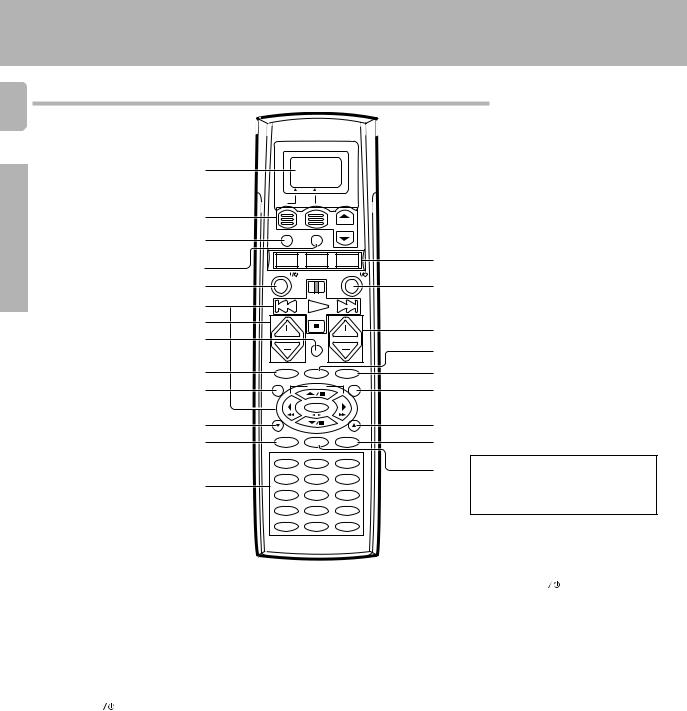
Remote control unit
6
Preparations
1
2
3
4
5
6
7
8
9
0
!
@
#
SHIFT |
MACRO |
|
MUSIC |
MOVIE |
TV |
AV POWER |
|
SYS. POWER |
CH. |
|
VOL. |
CH. |
|
VOL. |
|
MUTE |
|
DIMMER |
BASS BOOST |
SUB W. |
SOUND |
LISTEN M. |
THX |
TITLE/GUIDE |
TUNING |
MENU |
|
|
|
|
BAND |
|
|
ENTER |
|
RETURN |
|
OSD |
/PAGE |
|
/PAGE |
REC MODE |
AUTO/MONO |
|
|
|
|
REC |
F.SHIFT |
LEARN |
REPEAT |
RANDOM |
INPUT SEL. |
1 |
2 |
3 |
TV SELECT |
DISPLAY |
SELECT |
4 |
5 |
6 |
AUDIO |
THEME |
FAVORITE |
7 |
8 |
9 |
INFO. |
EXIT |
LAST CHANNEL |
+10 |
0 |
+100 |
10 |
11 |
12 |
RF REMOTE CONTROL UNIT |
||
|
RC-R0812 |
|
$
%
^
&
*
(
)
¡
™
Names and functions of parts
If the name of a function is different on the receiver and on the remote control, the name of the remote control key in the manual is indicated in parentheses.
1 Display |
|
|
¡ |
@ REC key |
‚ |
% SYS. POWER |
|
|
key |
™ |
|
|
|
||||||||
|
|
|
||||||||
2 Display operation keys |
¡ |
Use to operate the selected component. |
Use to turn the receiver on and off. |
|
||||||
Use for operation on the display. |
|
REC MODE key |
|
^ VOL. +/– keys |
|
¢ |
||||
3 SHIFT key |
|
|
‡ |
Use to select the REC MODE. |
|
Use to adjust the receiver volume. |
|
|||
Use in combination with the MUSIC and |
# Numeric keys/Source operation keys |
& LISTEN M. key |
|
¤ |
||||||
MOVIE keys to change the remote control |
|
¶ |
Use to select the listening mode. |
|
||||||
mode without changing the input selector. |
Provide functions identical to those of the |
BASS BOOST key (with F. SHIFT key) |
||||||||
4 MACRO key |
|
|
° |
original remote control supplied with the |
|
|
|
|
∞ |
|
Use in combination with the MUSIC, MOVIE, |
component you are controlling. |
|
Use to select the maximum adjustment set- |
|||||||
or TV keys to execute a series of commands |
To access the functions printed above the |
ting for the low frequency range. |
|
|||||||
automatically (MACRO PLAY). |
|
keys, press the numeric key after pressing |
* THX key |
|
∞ |
|||||
5 AV POWER |
|
key |
‡ |
the F. SHIFT key. Function availability varies |
Use to switch the status of THX. |
|
||||
|
|
|||||||||
|
|
|||||||||
Use to turn various components on and off. |
for each component. |
|
SUB W. key (with F. SHIFT key) |
fi |
||||||
6 Multi control keys |
‚ |
$ MUSIC key |
¢ |
Use in combination with the volume +/– |
||||||
Use to control a variety of settings. |
|
Selects the audio inputs and sets the remote |
keys to adjust the volume of the subwoofer. |
|||||||
Use to operate other components. |
|
control to operate the component regis- |
( MENU key |
|
|
|||||
7 CH +/– keys |
|
|
‚ |
tered at the respective input. |
|
Use to operate other components. |
|
|||
Use to select the channel. |
|
If you connect audio components from |
) 5 key |
|
|
|||||
8 MUTE key |
|
|
∞ |
KENWOOD and other makers to the MD/ |
Use to operate other components. |
|
||||
Use to temporarily mute the sound. |
|
TAPE or CD jacks, you can set the remote |
OSD/PAGE key |
|
‚ |
|||||
9 SOUND key |
|
|
∞ |
control to operate these components by |
Use to operate other components. |
|
||||
Use to adjust the sound quality and ambi- |
registering the appropriate setup code at |
¡ LEARN key |
|
‚ |
||||||
ence effects. |
|
|
|
the respective input. |
|
Use to memorize the operation of the other |
||||
DIMMER key (with F.SHIFT key) |
fi |
MOVIE key |
¢ |
remote control units. |
|
|||||
Use to adjust the brightness of the display. |
Selects the video inputs and sets the remote |
™ F. SHIFT key |
|
∞ |
||||||
0 TITLE/GUIDE key |
‚ |
control to operate the component regis- |
Use in combination with the numeric keys to |
|||||||
Use to operate other components. |
|
tered at the respective input. |
|
execute alternate commands. |
|
|||||
! ∞ key |
|
|
|
TV key |
‡ |
Turn the light of the display on and off by |
||||
Use to operate other components. |
|
Sets the remote control to operate a TV or |
pressing and holding this key for more than |
|||||||
RETURN/PAGE key |
‚ |
cable box. This key does not change the |
2 seconds. |
|
|
|||||
Use to operate other components. |
|
input selector on the receiver. |
|
|
|
|
|
|
||
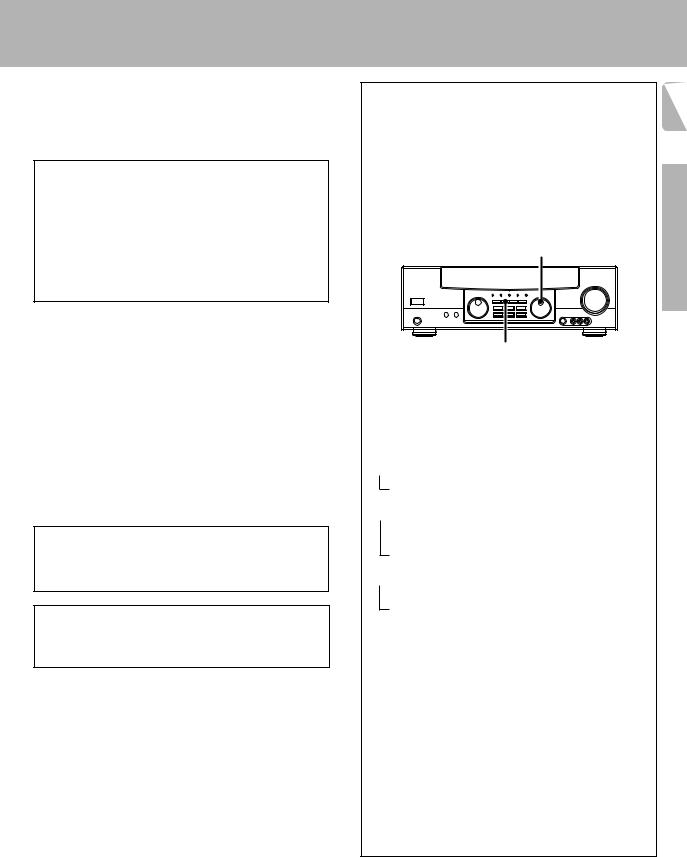
Setting up the system
Make connections as shown on the following pages. When connecting the related system components, be sure to also refer to the instruction manuals supplied with the components you are connecting.
Do not connect the power cord to a wall outlet until all connections are completed.
DTS disclaimer clause
DTS Digital Surround™ is a discrete 5.1 channel digital audio format available on CD, LD, and DVD software which consequently cannot be decoded and played back inside most CD, LD, or DVD players. For this reason, when DTS-encoded software is played back through the analog outputs of the CD, LD, or DVD player, excessive noise will be exhibited. To avoid possible damage to the audio system, proper precautions should taken by the consumer if the analog outputs are connected directly to an amplification system. To enjoy DTS Digital Surround™ playback, an external 5.1 channel DTS Digital Surround™ decoder system must be connected to the digital output (S/P DIF, AES/EBU, or TosLink) of the CD, LD or DVD player.
Notes
1.Be sure to insert all connection cords securely. If their connections are imperfect, the sound may not be produced or noise may interfere.
2.Be sure to remove the power cord from the AC outlet before plugging or unplugging any connection cords. Plugging/unplugging connection cords without disconnecting the power cord can cause malfunctions and may damage the unit.
3.Do not connect power cords from components which power consumption is larger than what is indicated on the AC outlet at the rear of this unit.
Analog connections
Audio connections are made using RCA pin cords. These cables transfer stereo audio signal in an “analog” form. This means the audio signal corresponds to the actual audio of two channels. These cables usually have 2 plugs on each end, one red for the right channel and one white for the left channel. These cables are usually packaged with the source unit, or are available at your local electronics retailer.
Microcomputer malfunction
If operation is not possible or an erroneous display appears, even though all connections have been made properly, reset the microcomputer referring to “In case of difficulty”. o
CAUTION
Be sure to adhere to the followings, or proper ventilation will be blocked causing damage or fire hazard.
• Do not place any objects impairing heat radiation onto the top of unit.
Input mode settings
CD/DVD, DVD/6ch, VIDEO2 and VIDEO3 inputs each include jacks for digital audio input and analog audio input.
You must select beforehand which type of input is to be used for each connected component.
The initial factory settings for audio signal playback (CD/DVD, DVD/6ch) and (VIDEO2, VIDEO3) are digital and analog respectively.
To use the analog audio input for playback instead (if, for example, you have connected a VCR to the VIDEO2 or VIDEO3 input), you must set the input mode for the corresponding input to the analog mode.
After completing connections and turning on the receiver, follow the steps below.
INPUT SELECTOR
INPUT MODE
1Use the INPUT SELECTOR knob to select CD/DVD, DVD/6ch, VIDEO2, or VIDEO3.
2Press the INPUT MODE key.
Each press switches the setting as follows:
In DTS play mode
 1 D-AUTO (digital input, auto sound)
1 D-AUTO (digital input, auto sound)
2 D-MANUAL (digital input, manual sound)
In DVD/6ch play mode
 1 D-AUTO (digital input, auto sound)
1 D-AUTO (digital input, auto sound)
2 D-MANUAL (digital input, manual sound)
3 6ch INPT (DVD/6ch input)
4 ANALOG (analog input, manual sound)
In modes other than DTS or DVD/6ch play mode
 1 D-AUTO (digital input, auto sound)
1 D-AUTO (digital input, auto sound)
2 D-MANUAL (digital input, manual sound)
3 ANALOG (analog input, manual sound)
Digital input:
Select this setting to play digital signals from a DVD, CD, or LD player.
Analog input:
Select this setting to play analog signals from a cassette deck, VCR, or turntable.
Auto sound:
In the auto sound mode (AUTO SOUND indicator lights), the receiver selects the listening mode automatically during playback to match the type of input signal (Dolby Digital, PCM, DTS ) and the speaker setting. The initial factory setting is auto sound on.
To keep the receiver set to the currently selected listening mode, use the INPUT MODE key to select “D-MANUAL” (manual sound). However, even when this setting is selected, there may be cases in which the listening mode is selected automatically to match a Dolby Digital source signal depending on the combination of listening mode and source signal.
If the INPUT MODE key is pressed quickly, sound may not be produced.
7
Preparations
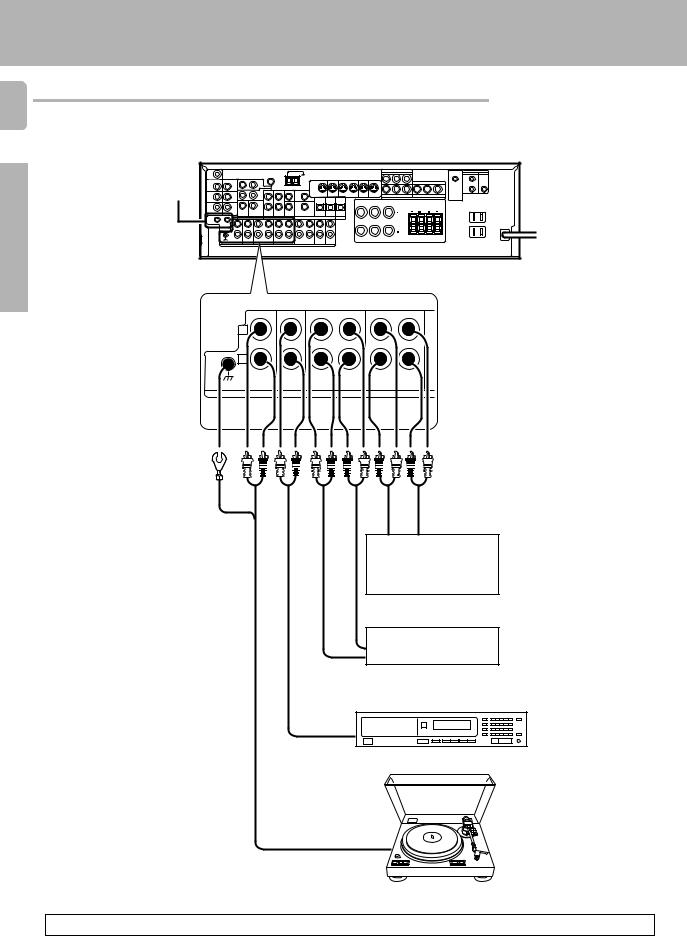
Setting up the system
Connecting audio components
8
SYSTEM CONTROL |
|
|
S VIDEO |
PLAY IN REC OUT |
PLAY IN |
PLAY IN |
PLAY IN |
|
|
|
|
jacks |
) |
R |
L |
L |
|
|
|
|
|
|
|
|
|
|
|
MONITOR |
|
|
|
|
|
|
|
|
|
|
|
OUT |
DVD VIDEO 1 |
VIDEO 1 |
VIDEO 2 |
VIDEO 3 |
|
|
|
Preparations |
|
|
|
|
|
|
|
|
|
B |
|
|
|
|
R |
|
|
|
|
R |
L |
|
|
|
|
|
|
|
|
|
A |
L |
R |
L |
To AC wall outlet |
|
|
|
|
|
|
|
R |
C |
|
|
|
|
L |
|
|
|
|
R |
|
|
|
|
|
|
REC OUT PLAY IN |
REC OUT PLAY IN |
GND |
PHONO |
CD/DVD |
MD/TAPE |
MONITOR |
|
|
|
|
AUDIO |
IN OUT
Video component,
3 head cassette deck, or Graphic equalizer §
OUT
Cassette deck or MD recorder
IN
OUT
CD player
OUT
Moving Coil (MC) cartridge record player cannot be used directly from the receiver unit. It can only be used when another equalizer amplifier is connected
Record player
When you connect the unit and the CD or MD player with the digital connection, you can enjoy a better sound quality.
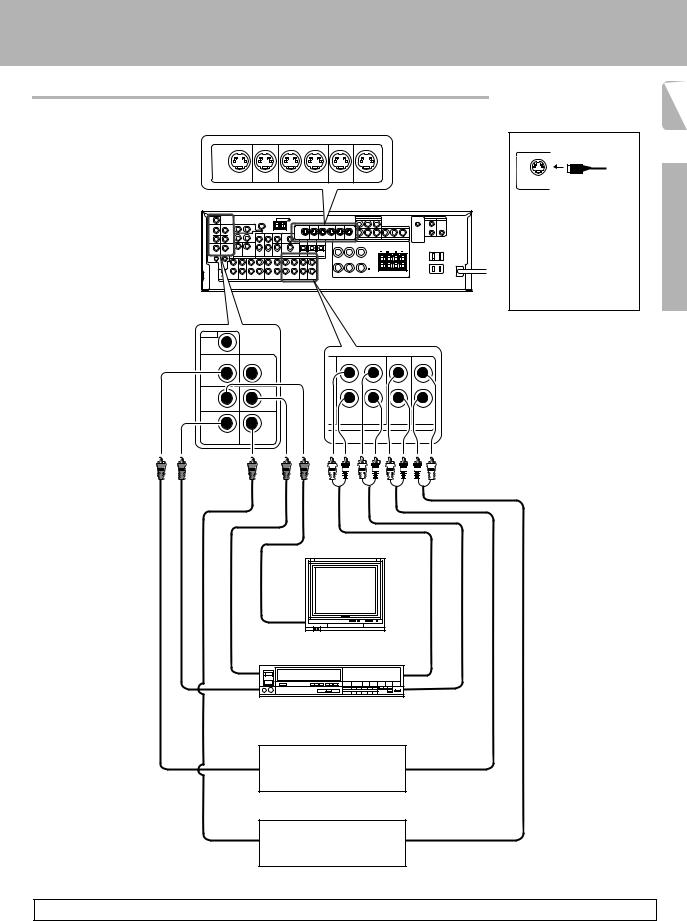
Setting up the system
Connecting video components
S Video jacks
S-VIDEO |
PLAY IN |
REC OUT |
PLAY IN |
PLAY IN |
PLAY IN |
MONITOR |
DVD |
VIDEO 1 |
VIDEO 1 |
VIDEO 2 |
VIDEO 3 |
OUT |
R |
L |
L |
|
|
|
|
|
|
|
|
|
|
B |
|
|
R |
|
|
R |
L |
|
|
|
A |
|
R |
L |
|
|
R |
L |
C |
|
About the S VIDEO jacks
S VIDEO
Use the S VIDEO jacks to make connections to video components with SVIDEO IN/ OUT jacks.
÷If you use the S VIDEO jacks to connect your video playback components, be sure to use the S VIDEO jacks when connecting your monitor and video recording components.
VIDEO
ROOM B
OUT
VIDEO 2 IN |
CD/DVD IN |
|
DVD |
MONITOR |
VIDEO 1 |
|
|
|
OUT |
OUT |
|
|
|
|
REC OUT |
PLAY IN |
PLAY IN |
PLAY IN |
|
VIDEO 1 |
VIDEO 2 |
VIDEO 3 |
|
VIDEO 1 IN |
VIDEO 3 IN |
|
|
|
9
Preparations
Monitor TV |
|
VIDEO IN |
|
VIDEO |
AUDIO |
IN / OUT |
IN / OUT |
IN |
|
Video Inputs |
|
(Yellow RCA pin cord) |
|
Video deck |
|
IN |
IN |
|
|
OUT |
OUT |
Video inputs and |
Audio inputs |
outputs |
and outputs |
(yellow RCA pin cord) |
|
OUT |
OUT |
DVD player or LD player |
|
OUT |
OUT |
DVD player or LD player
A video component with digital audio outputs should be connected to the VIDEO2 or VIDEO3 jacks.
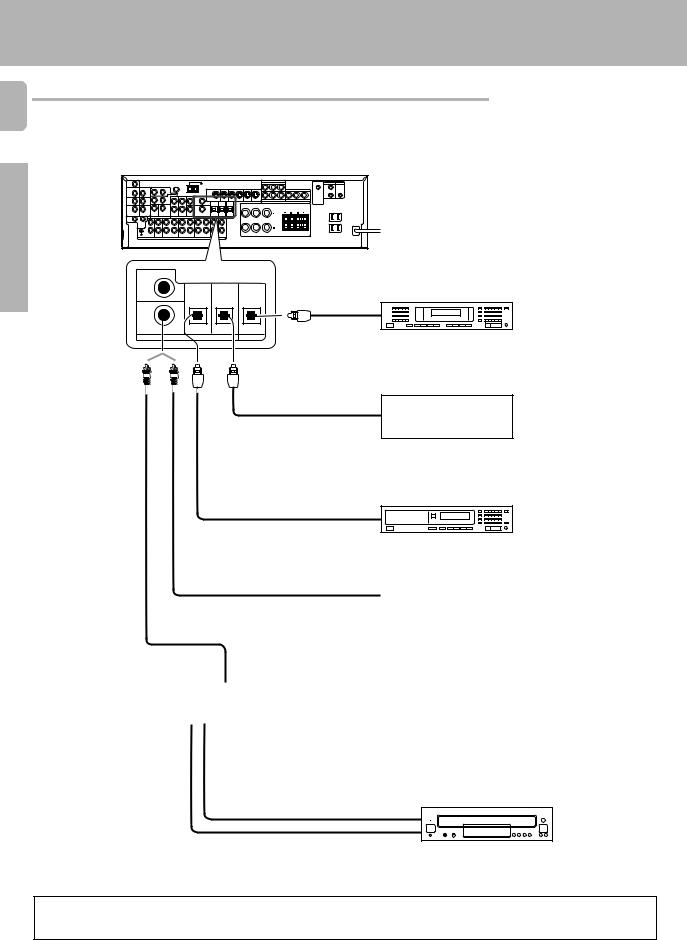
Setting up the system
Digital connections
10 The digital in jacks can accept DTS, Dolby Digital, or PCM signals. Connect components capable of outputting DTS, Dolby Digital, or standard PCM (CD) format digital signals.
If you have connected any digital components to the receiver, be sure to read the “Input mode settings” section
carefully. |
7 |
Preparations
R |
L |
L |
|
|
|
|
|
|
|
|
|
|
B |
|
|
R |
|
|
R |
L |
|
|
|
A |
|
R |
L |
|
|
R |
L |
C |
|
DVD
OPTICAL DIGITAL IN (AUDIO)
VIDEO 2 |
CD/DVD |
VIDEO 3 |
MONITOR |
|
COAXIAL |
OPTICAL |
OPTICAL |
OPTICAL |
MD player |
|
DIGITAL IN |
|
DIGITAL OUT |
OPTICAL DIGITAL OUT
(AUDIO) Component with DTS, Dolby
Optical fiber cable
Digital, or PCM OPTICAL
DIGITAL OUT
Connect the video signal and digital audio signals to the VIDEO 3 jacks. (See “Connecting video components”.) 9
OPTICAL DIGITAL OUT (AUDIO)
|
|
|
CD player |
|
|
|
|
COAXIAL DIGITAL OUT |
|
|
|
Component with DTS, Dolby |
|||||
|
|
(AUDIO) |
|||
|
|
|
Digital, or PCM COAXIAL |
|
|
|
|
|
DIGITAL OUT |
|
|
|
|
|
|
||
|
|
|
Connect the video signal and |
||
|
|
|
analog audio signals to the VIDEO |
||
COAXIAL DIGITAL |
2 jacks. (See “Connecting video |
||||
components”.) |
9 |
||||
OUT (AUDIO) |
|||||
|
|
|
|
|
|
|
RF digital |
|
|
|
|
|
demodulator |
|
|
|
|
|
(DEM-9991D) |
|
|
|
|
|
(sold separately) |
|
|
|
|
DOLBY DIGITAL RF OUT (AUDIO)
PCM OUT
LD player
To connect an LD player with a DIGITAL RF OUT, connect the LD player to the KENWOOD RF digital demodulator (DEM-9991D). Next, connect the DIGITAL OUT jacks of the demodulator to the DIGITAL IN jacks of the receiver.
Connect the video signal and analog audio signals to the VIDEO 2 or VIDEO 3 jacks. (See “Connecting video components”.)
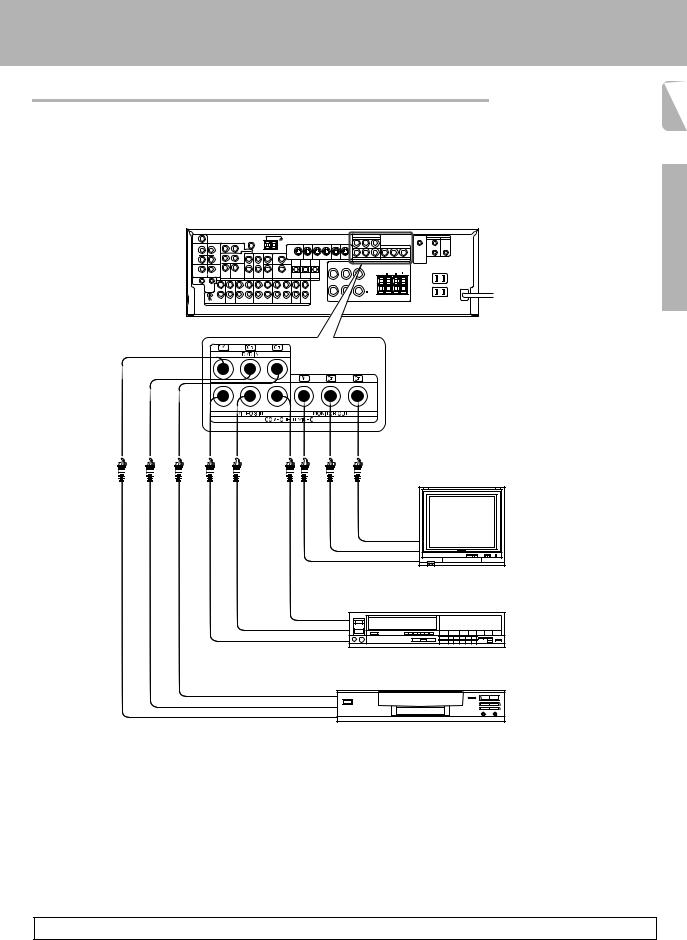
Connecting video components (COMPONENT VIDEO)
If you have connected the receiver to a video component with COMPONENT jacks, you can get a better picture quality than by connecting to the S-VIDEO jacks.
Setting up the system
11
Preparations
Monitor TV (with component jacks)
CR IN
CB IN
Y IN
Video Recorder, DVD Recorder, Satellite Cable Tuner & Game Player (with component jacks)
CR OUT CB OUT
Y OUT
DVD player (with component jacks)
CR OUT
CB OUT
Y OUT • Connect to the VIDEO cord.
When connecting the TV to the COMPONENT jacks, be sure to connect all the other components to the COMPONENT jacks.

Setting up the system
Connecting a DVD player (6-channel input)
12 If you have connected a DVD player to the receiver with digital connection, be sure to read the “Input mode settings”
section carefully. |
7 |
Preparations
|
|
S VIDEO |
PLAY IN |
REC OUT |
PLAY IN |
PLAY IN |
PLAY IN |
|
|
R |
L |
L |
|
|
|
|
|
|
|
|
|
MONITOR |
|
|
|
|
|
|
|
|
|
OUT |
DVD |
VIDEO 1 |
VIDEO 1 |
VIDEO 2 |
VIDEO 3 |
|
|
|
|
|
|
|
|
|
|
R |
B |
|
|
R |
|
|
|
|
|
L |
|
|
|
|
|
|
|
A |
L |
R |
L |
|
|
|
|
|
|
R |
C |
|
VIDEO |
L |
|
CENTER |
DVD |
PLAY IN |
|
|
|
|||
ROOM B |
|
|
|
|
|
OUT |
|
|
|
|
|
VIDEO 2 IN |
CD/DVD IN |
|
|
|
DVD |
|
DVD |
|
|
|
|
|
R |
|
SUB |
VIDEO 2 |
|
MONITOR |
VIDEO 1 |
FRONT SURROUND |
|
||
WOOFER |
COAXIAL |
|
|||
OUT |
OUT |
DVD / 6CH. INPUT |
|
|
|
VIDEO 1 IN |
VIDEO 3 IN |
S VIDEO cord
VIDEO OUT |
FRONT |
SURROUND |
|
(Yellow RCA |
OUT L/R |
OUT L/R |
CENTER OUT |
pin cord) |
|
|
|
|
DVD player |
|
SUBWOOFER OUT |
|
|
|
|
|
|
COAXIAL |
|
|
|
DIGITAL |
|
|
|
OUT |
|
|
|
(AUDIO) |
|
|
S VIDEO |
|
|
|
OUT |
|
|
To switch the speakers off , turn SPEAKERS A and B OFF or press MUTE key on the remote control unit.
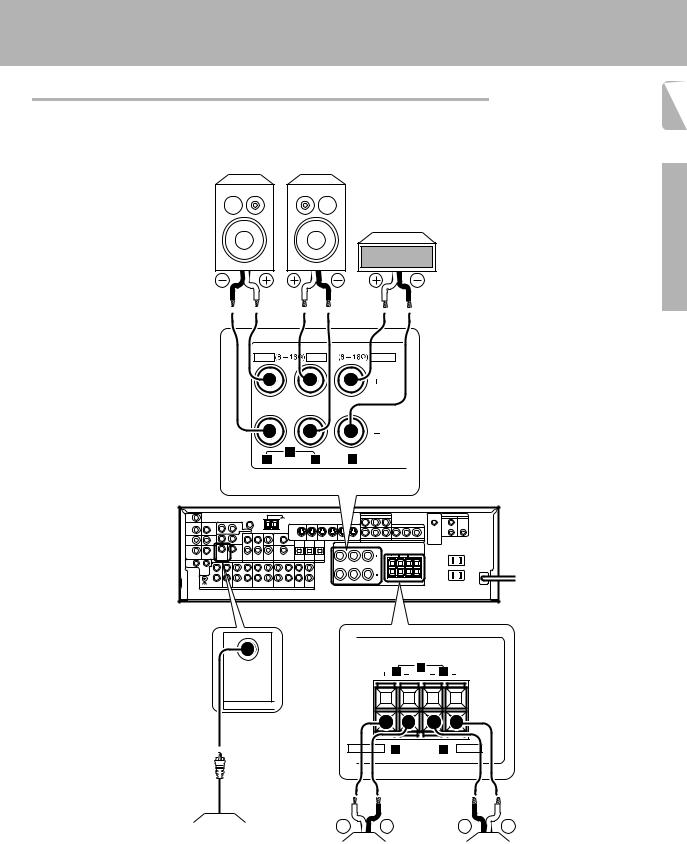
Connecting the speakers
Front Speakers A
Right Left
Center
Speaker
FRONT SPEAKERS |
CENTER SPEAKERS |
|
RED |
BLUE |
GREEN |
Setting up the system
13
Preparations
|
|
S VIDEO |
PLAY IN |
REC OUT |
PLAY IN |
PLAY IN |
PLAY IN |
|
|
R |
L |
L |
|
|
|
|
|
|
|
|
|
MONITOR |
|
|
|
|
|
|
|
|
|
OUT |
DVD |
VIDEO 1 |
VIDEO 1 |
VIDEO 2 |
VIDEO 3 |
|
|
|
|
|
|
|
|
|
|
R |
B |
|
|
R |
|
|
|
|
|
L |
|
|
|
|
|
|
|
|
|
|
|
|
|
|
|
|
|
A |
L |
R |
L |
|
|
|
|
|
|
R |
C |
|
|
FRONT SPEAKERS |
|
|
(8 – 16Ω) |
|
SUB |
|
|
WOOFER |
|
|
ORANGE |
(8 – 16Ω) |
GRAY |
|
SURROUND SPEAKERS |
|
Use the FRONT SPEAKERS B terminals if you want to connect a second front speaker system.
|
|
|
|
|
|
|
|
|
|
|
|
|
|
|
|
|
|
|
|
|
|
|
|
|
|
|
|
|
|
|
|
|
|
|
|
|
|
|
|
|
|
|
|
Powered |
Right |
|
|
|
|
Left |
|
|||
subwoofer |
|
Surround Speakers |
|
|||||||
(Be sure to connect both surround speakers)
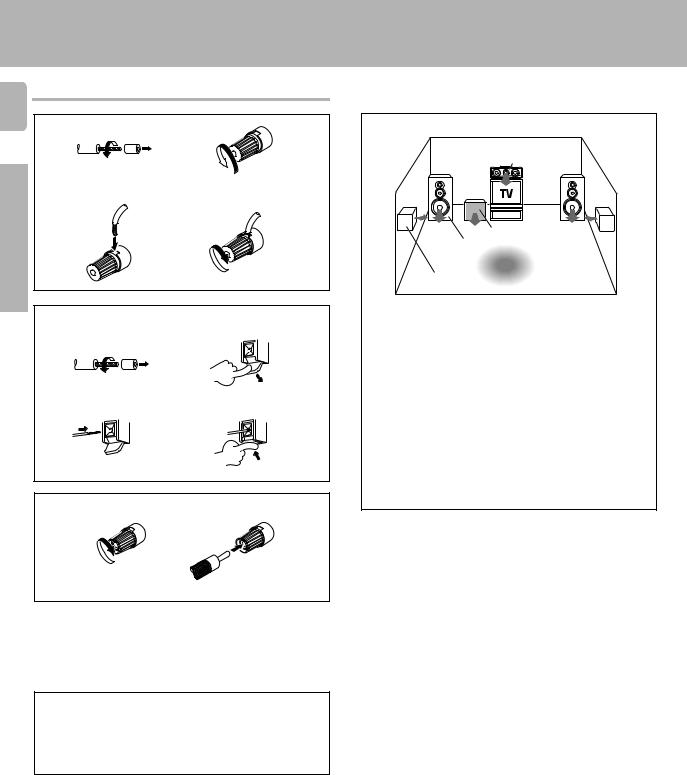
Connecting the terminals
14
1 Strip coating. |
2 Loosen. |
||
|
|
|
|
3 Insert. |
4 Secure. |
Preparations
1 Strip coating. |
2 Push the lever. |
|||
|
|
|
|
|
|
|
|
|
|
|
|
|
|
|
3 Insert the cord. |
4 Return the lever. |
Connection of banana plugs
1 Secure. |
2 Insert. |
•Sound will not be heard if the speaker terminal is not fully secured.
•Never short circuit the + and – speaker cords.
•If the left and right speakers are connected inversely or the speaker cords are connected with reversed polarity, the sound will be unnatural with ambiguous acoustic imaging. Be sure to connect the speakers correctly.
Speaker impedance
After confirming the speaker impedance indications printed on the rear panel of the receiver, connect speakers with matching impedance ratings. Using speakers with a rated impedance other than that indicated on the rear panel of the receiver could result in malfunctions or damage to the speakers or receiver.
Setting up the system
Speaker placement
Center speaker
Subwoofer
Front speaker
Listening Surround position speaker
Front speakers : Place to the front left and right of the listening position. Front speakers are required for all surround modes.
Center speaker : Place front and center. This speaker stabilizes the sound image and helps recreate sound motion. Be sure to connect a center speaker when using the Dolby 3 Stereo mode.
Surround speakers : Place to the direct left and right, or slightly behind, the listening position at even heights, approximately 1 meter above the ears of the listeners. These speakers recreate sound motion and atmosphere. Required for surround playback.
Subwoofer : Reproduces powerful deep bass sounds.
•Although the ideal surround system consists of all the speakers listed above, if you don't have a center speaker or a subwoofer, you can divide those signals between the available speakers in the speaker
settings steps to obtain the best possible surround reproduction from the speakers you have available. ™

Setting up the system
Connecting to another room (ROOM B)
This connection allows you to connect your main system to a monitor TV and speaker system located in another 15 area (ROOM B).
R |
L |
L |
|
|
|
|
|
|
|
|
|
|
B |
|
|
R |
|
|
R |
L |
|
|
|
A |
|
R |
L |
|
|
R |
L |
C |
|
VIDEO |
|
ROOM B |
FRONT |
OUT |
SURROUND |
Preparations
SUB
WOOFER CENTER
PRE OUT / ROOM B
Front speakers
Power amplifier
L R
Monitor TV
ROOM A |
ROOM B |
(Main System)
IR
RECEIVER
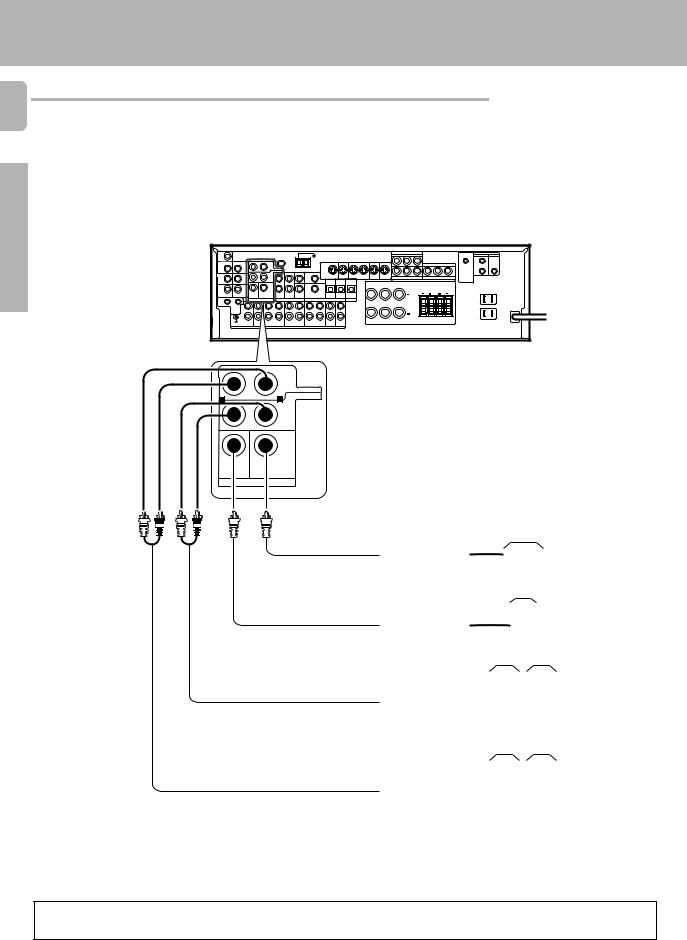
Setting up the system
PRE OUT connections
16 This receiver has additional preout jacks. These can be used for various purposes, but will need to be connected to an external power amplifier as shown in the example below.
Preparations
|
|
S VIDEO |
PLAY IN |
REC OUT |
PLAY IN |
PLAY IN |
PLAY IN |
|
|
R |
L |
L |
|
|
|
|
|
|
|
|
|
MONITOR |
|
|
|
|
|
|
|
|
|
OUT |
DVD |
VIDEO 1 |
VIDEO 1 |
VIDEO 2 |
VIDEO 3 |
|
|
|
|
|
|
|
|
|
|
R |
B |
|
|
R |
|
|
|
|
|
L |
|
|
|
|
|
|
|
A |
L |
R |
L |
|
|
|
|
|
|
R |
C |
|
FRONT
SURROUND
R |
L |
SUB
WOOFER CENTER
PRE OUT / ROOM B
Center Speaker
Power amplifier
|
|
|
|
|
|
|
|
|
|
|
|
|
|
|
|
|
|
|
|
|
|
|
|
|
|
|
|
|
|
|
|
Subwoofer |
|||||||
Power amplifier |
|
|
|
|
|
|
|||
|
|
|
|
|
|
||||
|
|
|
|
|
|
|
|
|
|
|
|
|
|
|
|
|
|
|
|
|
|
|
|
|
|
|
|
|
|
|
Surround speakers |
||||||||
|
|||||||||
Power amplifier |
|
|
|
|
|
|
|
|
|
|
|
|
|
|
|
|
|
||
|
|
|
|
|
|
|
|
|
|
|
|
|
|
|
|
|
|
|
|
|
|
|
|
|
|
|
|
|
|
|
|
L |
|
|
|
R |
|||
|
|
Front speakers |
|||||||
|
|
|
|
|
|
|
|
||
Power amplifier |
|
|
|
|
|
|
|
|
|
|
|
|
|
|
|
|
|
||
|
|
|
|
|
|
|
|
|
|
|
|
|
|
|
|
|
|
|
|
|
|
|
|
|
|
|
|
|
|
|
|
L |
|
|
|
R |
|||
•Connecting a speaker cord directly to a PRE OUT jack will not produce any sound from the speaker.
•To use the PRE OUT jacks, press only the SPEAKERS A key to the ON position.
•This connection is available for listening in ROOM B.
